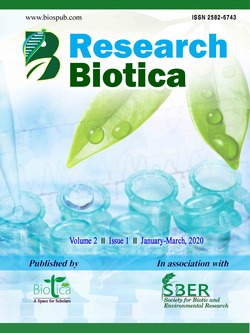
Fertility Assessment of Soil and Suitable Amelioration for Sustainable Quality Mulberry Leaf and Cocoon Production in Karnataka
P. Sudhakar*
Regional Sericultural Research Station, Central Silk Board (CSB), Ananthapur, Andhra Pradesh (515 001), India
V. Sobhana
Central Sericultural Research and Training Institute, Central Silk Board, Mysuru, Karnataka (570 008), India
M.R. Swamy Gowda
Regional Sericultural Research Station, Central Silk Board, Kodathi, Bangaluru, Karnataka (560 035), India
Sibayan Sen
Central Sericultural Research and Training Institute, Central Silk Board, Mysuru, Karnataka (570 008), India
M.V. Sneha
Central Sericultural Research and Training Institute, Central Silk Board, Mysuru, Karnataka (570 008), India
V. Sivaprasad
Central Sericultural Research and Training Institute, Central Silk Board, Mysuru, Karnataka (570 008), India
DOI: https://doi.org/10.54083/ResBio.2.1.2020.15-19
Keywords: Leaf production, Mulberry, Organic carbon, Soil analysis, Soil fertility
Abstract
The composite soil samples received from the various cluster sericulture farmer mulberry gardens (2067) of Karnataka state were subjected for their physical and chemical analysis for measuring their nutrient status. It was noticed that 52% soils characterised as clay loamy, 28% red loamy, 12% black cotton and only 8% soils were red lateritic in nature. Soil pH was recorded in the range of 6.10-7.96 with 7.03 average pH. Among them 59% soils comprised with desired pH (6.5 to 7.5%), 21% with high pH (>7.5) and 20% recorded with low pH (<6.5). Soluble salt content (EC) of the mulberry soils ranged from 0.11 to 0.90 with a mean value of 0.69 dS m-1. All most all the soils of the state (99%) recorded with desired levels of EC (<1.0 dS m-2) indicating ideal for mulberry. Organic Carbon (OC) was ranged from 0.12-1.06 with a mean value of 0.64%. Out of the soils 74% recorded with low OC (<0.65%) followed by 24% desired (0.65-1.0%) and 2% in rich OC (>1.0%) indicating that soils received were deficient in OC. The macronutrients (N, P & K) presence and distribution revealed that, available Nitrogen (N) registered in 116.4-349.8 with 212.3 kg ha-1 average content. Similarly 76% soils registered with low level of available nitrogen (<250 kg ha-1), 23% in medium (250-500 kg ha-1) whereas 1% with high N (>500 kg ha-1). Phosphorous (P) in the range of 3.69-103.9 with an average value of 30.1 kg ha-1. However the distribution of available P is in the ratio of 36:34:30 of high (P>25 kg ha-1), low (P<15 kg ha-1) and desired levels of P (15-25 kg ha-1), respectively. Potassium (K) content was ranged in 181.7-905.4 with a mean value of 521.7 kg ha-1. The K distribution was high (>240 kg ha-1) in 42% soils followed by 40% in desired level (120-240 kg ha-1) and 18% soils recorded with lower quantities of available K (<120 kg ha-1). The micronutrients such as available Sulphur (S) and Boron (B) present in the range of 10.50-117.30 and 0.08-2.87 with a mean value of 63.90 & 1.48 ppm ha-1, respectively. Sulphur distribution was noticed that 71% soils registered rich in S (>15 ppm), 21% medium (10-15 ppm ha-1) and 15% soils represent deprived levels of S (<10 ppm). Boron was found medium level (0.5-1.0 ppm ha-1) in 48% soils followed by 30% with low level B (<0.5 ppm ha-1) and 22% soils with high amount of B (>1.0 ppm ha-1). Based on the above findings suitable soil amelioration prescriptions were served in the form of ‘Soil Health Cards’ for correcting their mulberry gardens to minimise the cost of production thereby achieving quality mulberry leaf production for the development of Bivoltine sericulture.
Downloads
not found
Reference
Anonymous, 2011. Methods Manual: Soil Testing in India. Dept. of Agriculture and Co-operation, Ministry of Agriculture, Govt. of India, New Delhi. pp. 1-208.
Dandin, S.B., Jayaswal, J., Giridhar, K., 2003. Handbook of Sericulture Technologies. Central Silk Board, Bangalore, India. pp. 1-259.
Chen, F., Lu, J., Zhang, M., Wan, K., Liu, D., 2009. Mulberry nutrient management for silk production in Hubei Province of China. Journal of Plant Nutrition and Soil Science 172(2), 245-253. DOI: https://doi.org/10.1002/jpln.200800093.
Kar, R., Bose, P.C., Majumdar, S.K., Dutta, R.N., 2008. Physical characterization of mulberry (Morus sp.) growing soils in four states of eastern India in relation to their organic carbon and available nutrient contents. Indian Journal of Agricultural Research 47(1), 126-129.
Kurose, T., 1966. Studies on dietetical value of phosphorus deficient mulberry leaves. VI. Influence of arginine on the growth of silkworm larvae. Journal of Sericultural Science of Japan 32, 121-124.
Pradhan, L., Dixit, L., Rout, D., Misra, A., 1992. Effect of source of nitrogen and yield of groundnut (Arachis hypogea) in acid lateritic soils of Orissa. Indian Journal of Agronomy 37(2), 273-275.
Prasad, R., Sharma, S.N., Singh, S., 1992. Fertilizer nitrogen Interaction in crop production. Fertilizer News 37(4), 75-83.
Sarkar, A., 2000. Improvement in mulberry-current status and future strategies, Lead paper In: National Conference on Strategic Sericultural Research, Central Sericultural Research and Training Institute, Mysore, India. pp. 1-11.
Subbaswamy, M.R., Singhvi, N.R., Naidu, B.V., Reddy, M.M., Jayaram, H., Suryanarayana, N., 2001. Effect of source of nitrogen on phosphorus uptake and arginine content in mulberry. Indian Journal of Sericulture 40(2), 182-184.
Sudhakar, P., Sobhana, V., Swamy Gowda, M.R., Kumar, J.S., Sivaprasad, V., 2018. Soil fertility status of mulberry (Morus alba L.) soils under bivoltine sericultural areas of north, south and eastern regions of Karnataka. International Journal of Advanced Research 6(4), 132-140.
